Harley Davidson V-Rod Turbo Kit Installation
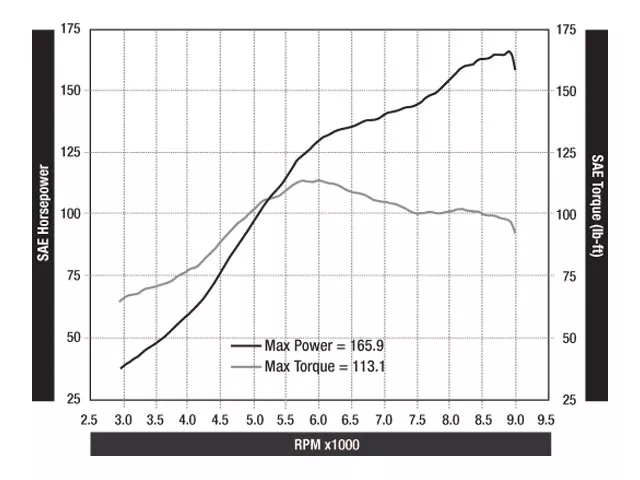
The dyno chart is proof of the pudding. The V-Rod’s turbocharged engine dyno’d at 165.9 hp at 8,900 rpm and 113.1 lb-ft of torque at 5,700 rpm on 91-octane pump gas, compared to a stock 104 hp and 74 lb-ft of torque. If you want to increase the horsepower of your stock V-Rod by 60 percent or more without cracking the engine, Custom Performance’s Trask Turbo System may be just the ticket for you.
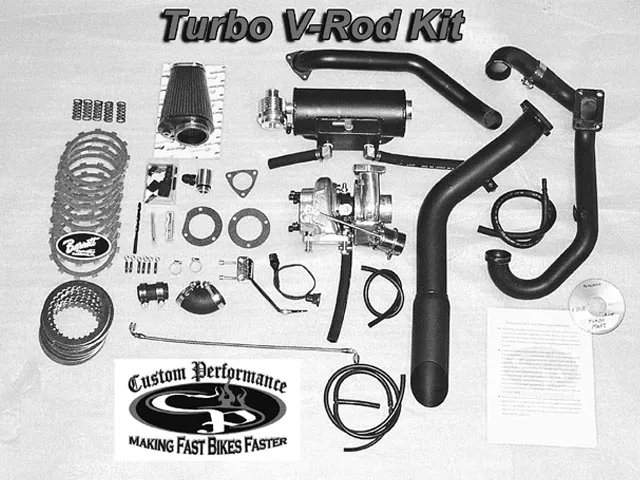
The Trask V-Rod Turbo System comes complete, including a Garrett turbocharger, optimized intake plenum, intake and exhaust systems, K&N; air filter, performance carbon-fiber clutch pack, EFI fuel maps for the H-D Race Tuner, and instructional CD.
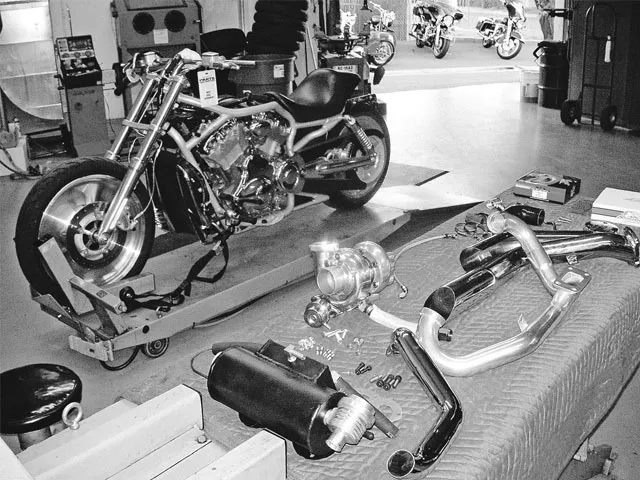
Turbo installation started with the removal of the air-box cover, air filter, and filter housing. The air-temperature sensor, which is located inside the air box, would be relocated later.
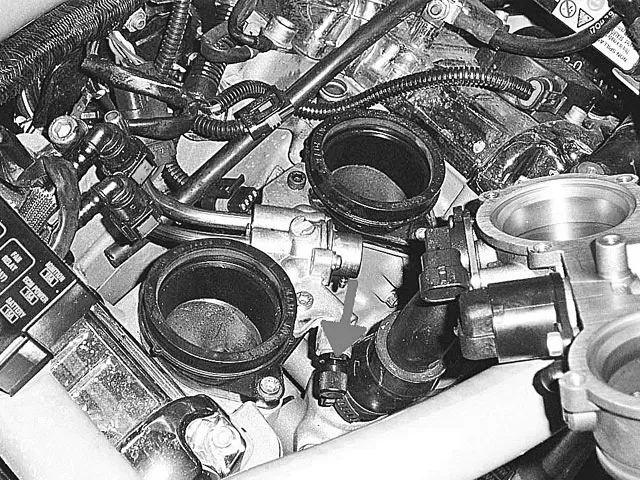
After removing the filter and housing, residual fuel pressure was bled by depressing the fuel Shrader valve under the plastic cover (indicated by arrow).
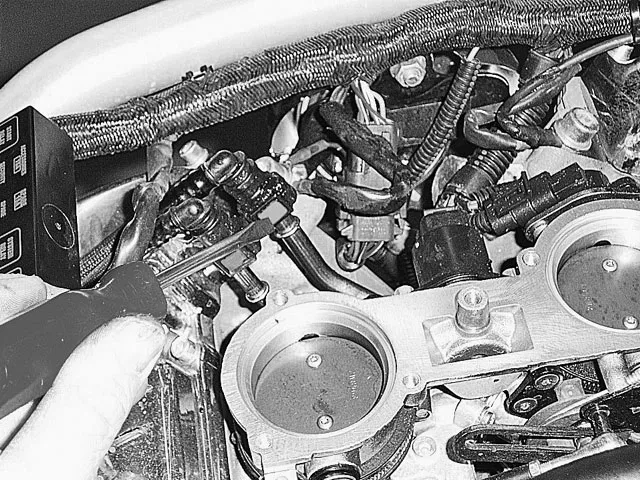
The line was then removed by pressing the line quick-disconnects (blue tabs).
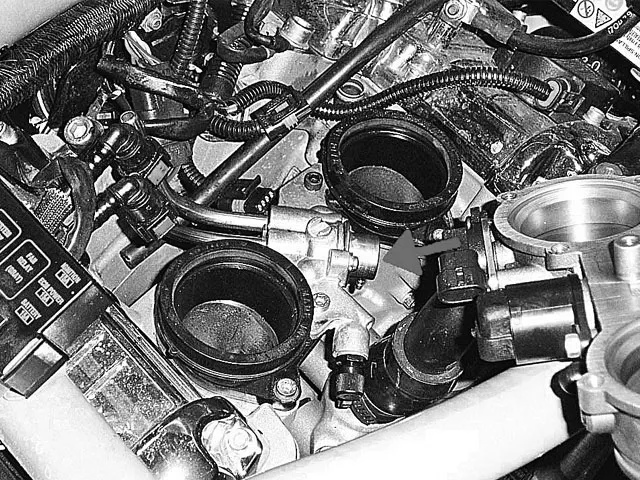
The fuel-pressure regulator was removed by unplugging the throttle-position sensor and injector wiring, loosening the clamps on the intake boots, removing the injector hold-down bolts, and moving the throttle body out of the way.

Once the pressure regulator was removed, threads were tapped into its vent hole using a 10×32 tap to install a vacuum fitting that would be used to monitor turbo boost pressure. Next, the modified fuel-pressure regulator, throttle body, wiring, and fuel lines were reinstalled.
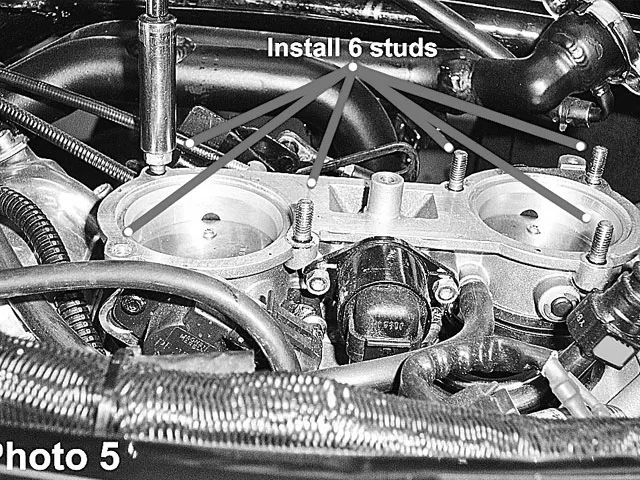
Six studs (included) were then screwed into the top of the throttle body after applying a dab of LocTite. For installation, Custom Performance recommends using the double-nut and socket method on the studs.
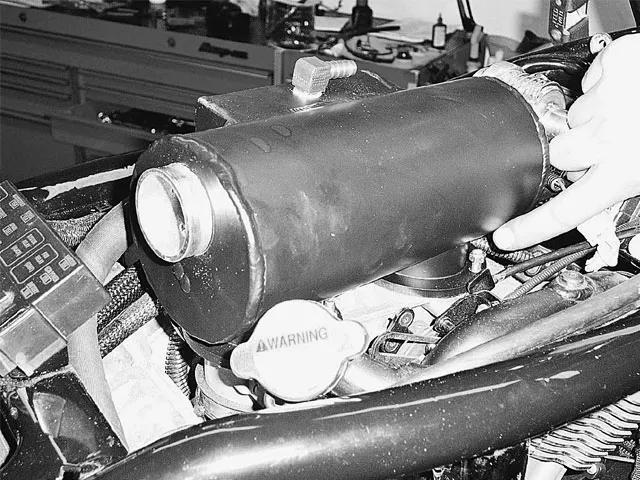
Once the throttle-body studs were installed, new intake gaskets were placed on the throttle body, and the performance-designed intake plenum was secured onto the throttle body with nuts. The new plenum replaces the stock air box. Note the position of the cooling-system fill tube and cap with the word “Warning,” because the tube must be modified for clearance.
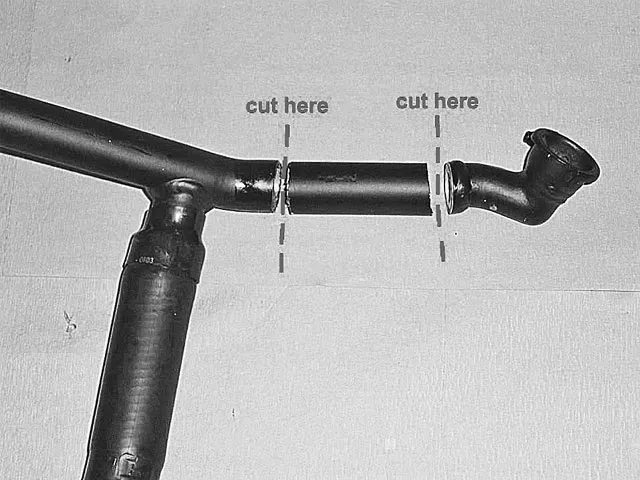
After installing the plenum, a container was placed under the radiator, the drain plug was removed, and the cooling-system fluid was drained. Next, the upper radiator hose and fill-tube assembly were removed. To provide additional clearance for the turbo kit, the fill tube was cut as indicated, and the centerpiece replaced with the included flexible hose and two clamps.
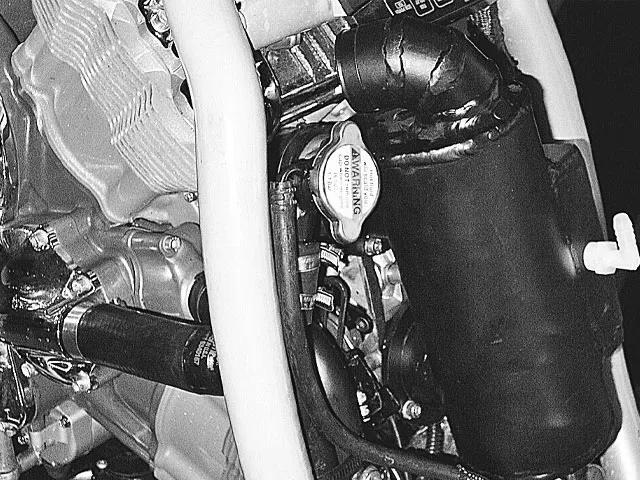
Once modified, the cooling fill tube was reinstalled and the system refilled with fluid.

After reinstalling the cooling-system fill tube, the engine oil was drained, the oil filter removed, the oil line to the filter adapter disconnected, and the adapter removed from the front of the engine. Since the turbo is lubricated with crankcase oil, the filter adapter was drilled and tapped for the oil feed line to the turbo. Using the supplied 5/16-inch drill bit, the adapter was drilled through the center of the boss.
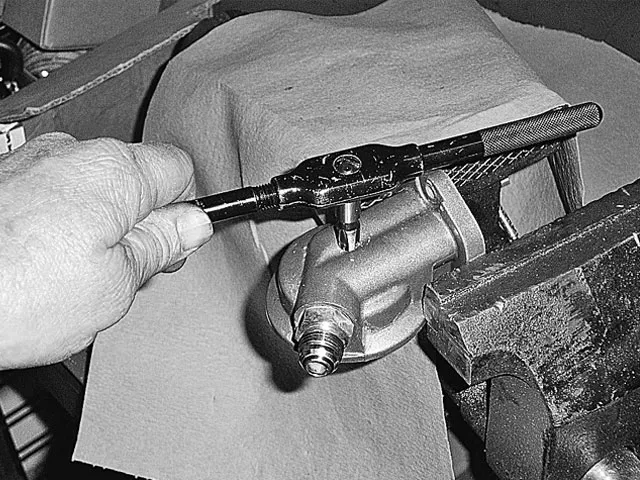
The new hole was threaded with a 1/8×27 NPT pipe tap.

A dab of sealant was applied to the fitting (included), and the fitting was threaded into the adapter.

After modifying the oil-filter adapter, the stock exhaust system and engine primary cover were removed, along with the stock clutch plates and springs.

The included Barnett carbon-fiber clutch pack and springs were then installed. The main clutch nut was torqued to 165 lb-ft and the 6mm bolts to 85 lb-ft in a crisscross sequence.
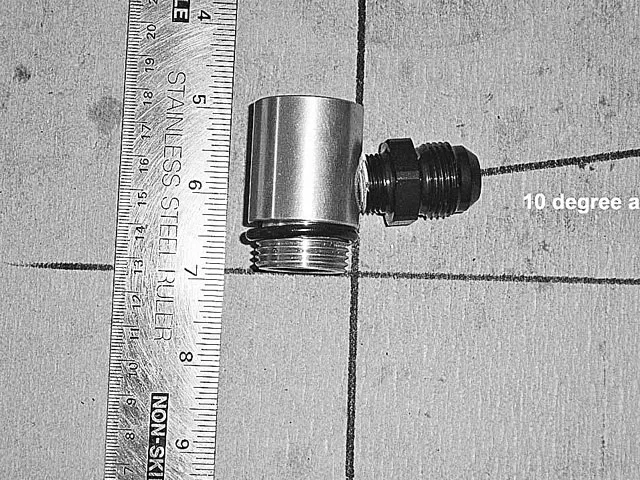
The crankcase oil-filler plug (dipstick) was removed and the included adapter installed. The adapter was hand-tightened and the oil fitting aligned toward the bike’s right side. The adapter provides a fitting for the turbo’s oil return line.
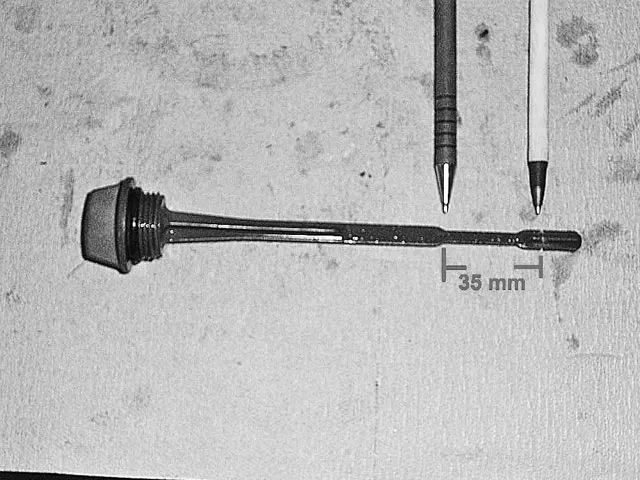
The stock crankcase dipstick was retained, but it had to be re-marked to account for the adapter height. The dipstick’s stock full line was lowered 35mm by cutting a slight groove in the stick.
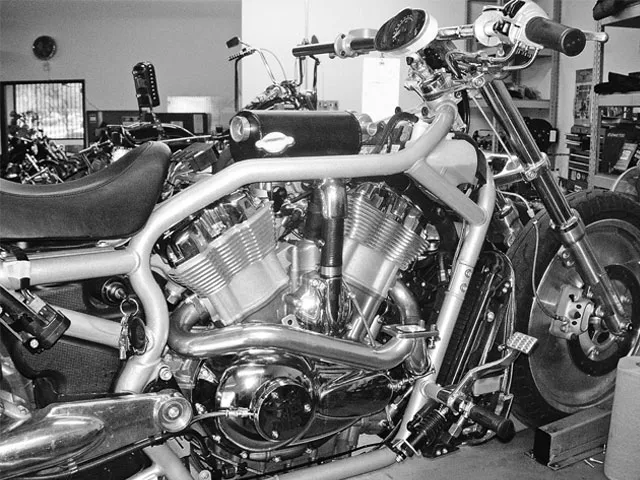
After installing gaskets on both cylinder exhaust ports, the exhaust manifold was installed, but the clamp bolts were only hand-snugged for final adjustment later.
After the exhaust manifold was installed, a thin film of high-temp silicone was applied to the manifold’s turbocharger mounting flange. Next, the turbo and exhaust pipe were mounted as a unit and secured. Note that the exhaust pipe had been previously mounted to the turbo. The turbo’s oil feed and return lines were connected.
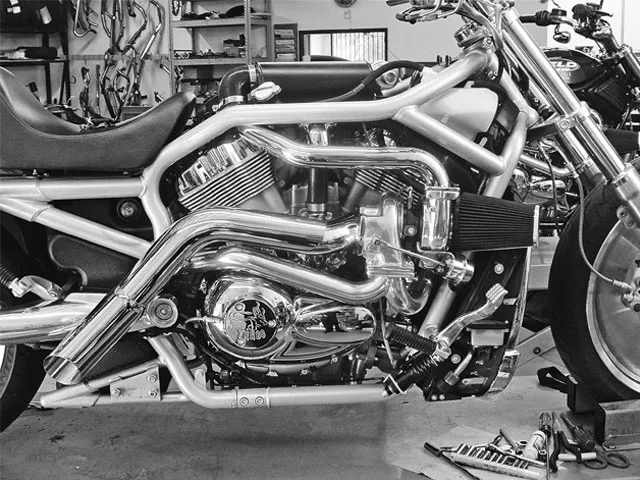
Once the turbocharger was secured, the intake pipe, which supplies pressurized air from the turbo to the throttle-body plenum, was installed using the supplied clamps and bolts. Next, the exhaust-manifold clamps were given a final tightening, and the waste gate and fuel-pressure regulator vacuum hoses were connected to the intake plenum. Finally, the K&N; air filter was installed on the turbocharger intake.
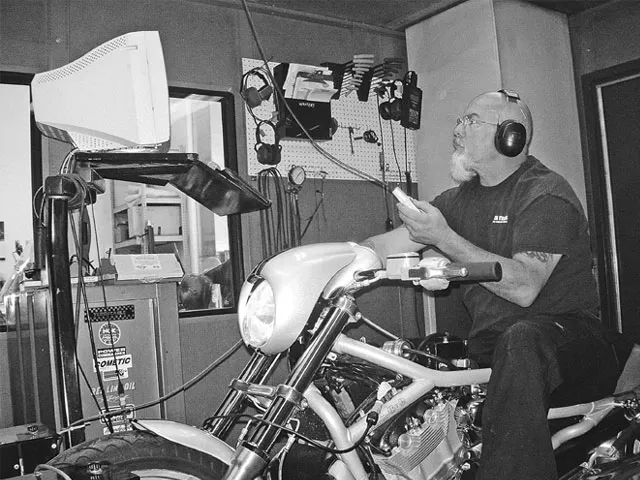
Before starting the engine, the crankcase had been filled with oil to the recommended level, the cooling system filled, the bike checked for leaks, and all kit parts checked for tightness. Once the engine was started, the bike was again checked for leaks and any unusual sounds. Then the engine was shut off and again checked for leaks. Custom Performance recommends using the Harley-Davidson Race Tuner for EFI fuel and ignition calibration. The turbo kit’s CD-ROM contains several tuning maps. A map for 8 lbs boost and 91-octane fuel was downloaded to the ECM before Custom Performance dyno-tuned the engine for optimum power.
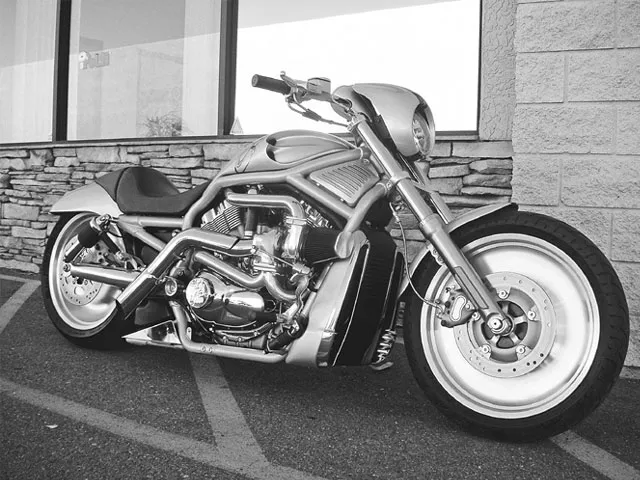
Here’s the completed V-Rod installation of CP’s Trask Turbo System. The compact turbo kit with Jet Hot-coated intake and exhaust manifolds and show-polished compressor housing results in a slick installation and clean, symmetrical design, along with outstanding power production.
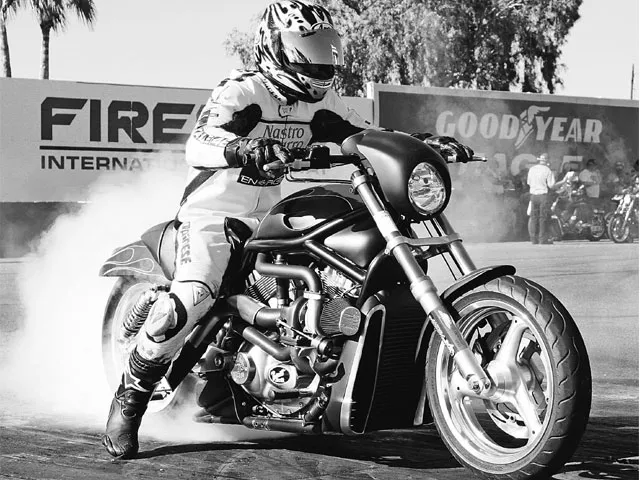
Kaz, from Super Kaz Racing, smokes the tires on a Competition Performance Turbo V-Rod at the recent Phoenix All Harley Drag Racing Association race.
An often-heard clich is “there’s more than one way to skin a cat.” And when it comes to making horsepower, nothing is closer to the truth. For example, many power aficionados take the bolt-on route when hopping up their V-Twins. Others subscribe to the “there’s no replacement for displacement” theory. Then there are those interested in something beyond the normally aspirated, embracing power-adders such as turbochargers, superchargers, and nitrous oxide.
One such shop is Custom Performance in Arizona. Tucked away in North Phoenix, Custom Performance has been quietly making big horsepower numbers with its Trask Turbocharger Systems for V-Rod, Twin-Cam, and Evo Harleys. Owned by former New Zealander Nick Trask, Custom Performance specializes in turbocharging V-Twin Harleys. When asked how he got interested in turbocharging, Nick said that Down Under all the racers are running turbocharged cars, and the cars run like bandits. So why not turbocharge a Harley?
Basically, a turbocharger is a compressor and is turbine-driven by the engine’s hot combustion gases as the gases exit the exhaust system. The compressor portion uses a fan-like impeller rotating at high speed to develop pressure or boost, which pressurizes the intake manifold above atmospheric pressure. The increased pressure differential between the manifold and cylinder allows a greater mass of air to flow into the cylinder than would by normal atmospheric pressure alone-thus the genesis of the terms “forced induction,” “power-adder,” and “normally aspirated.”
In the past, turbocharger kits for the V-Twin were almost nonexistent, and those that did exist were bulky. So Nick set out to design a turbocharger system that would not only complement the lines of the Harley V-Twin but would also make the V-Twin run like a bandit. The result is the Trask Turbo System. The heart of the Trask system is a Garrett compressor that uses ceramic instead of metal bearings to keep the turbo’s impeller spinning at very high rpm without failure under high-heat conditions. Trask Turbo Systems are custom-designed for specific Harley V-Twin models, including matching the compressor size to engine displacement and desired power output. Trask Turbo Systems come complete, including a custom intake plenum, Jet Hot-coated manifolds, show-polished compressor housing, and all the necessary hardware for installation. The kits are designed for 8 to 10 lbs of boost on 91-octane pump gas, include a CD-ROM with EFI Race Tuner maps for tuning fuel and spark curves, and are dyno-tested and track-proven. Custom applications are also available.
Custom Performance was starting installation of a Trask Turbo System on a stock Harley V-Rod, so Nick invited HOT BIKE to follow along and see just how simple it is to increase horsepower 60 percent or more on pump gas without even cracking open the motor. Check out the dyno chart and see for yourself whether a Trask Turbo System is your ticket for higher performance.







